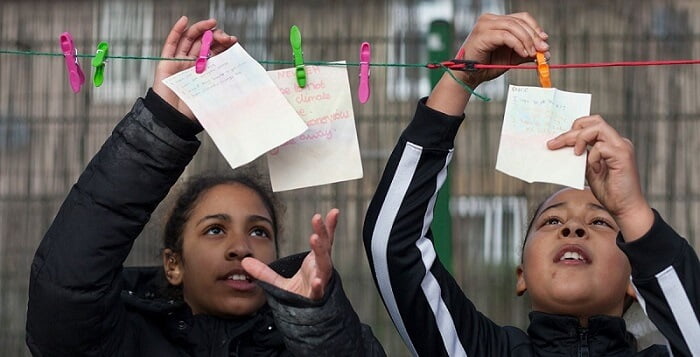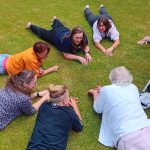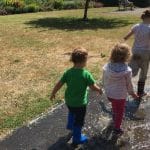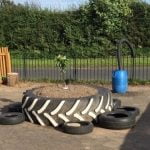How can educators best support children through climate anxiety?
 Learning through Landscapes CEO, Carley Sefton, reflects on how The Big Ask, the recent climate anxiety report and the Pre-COP26 youth summit must provoke some big conversations.
Learning through Landscapes CEO, Carley Sefton, reflects on how The Big Ask, the recent climate anxiety report and the Pre-COP26 youth summit must provoke some big conversations.
Last week was a bit of a sad one here at Learning through Landscapes (LtL). Our amazing Head of Project and Programmes, Heena Dave, left the team to undertake her PhD in Education and, while we are all so excited to see what she does next, we were sad to see her go.
But on Heena’s last day, we were delighted to be invited to have lunch with one of LtL’s founders: landscape architect and environmental activist, Merrick Denton-Thompson. As we sat overlooking the stunning Scottish countryside and discussing recent events, the conversation quickly turned to how much environmental awareness has changed for young people.
From Heena and I having our formative years during the ‘90s to Merrick enjoying his a few decades earlier, we agreed that during our collective youths there just wasn’t the same depth of scientific or public understanding of the climate crisis as there is today.
When I was growing up, I cared about the environment and thought I was doing my bit. I went on rubbish collections, took aluminium cans for recycling at our local supermarket, and my teenage self even did her best to reduce CFCs with a non-aerosol ‘self-pump’ hairspray. My walls were covered in anti-whaling posters from WWF and ‘against animal testing’ posters from The Body Shop.

But this week, in the wake of the Pre-COP26 youth summit and the publication of the Children Commissioner’s Big Ask report, I have thought a lot about the ‘90s version of me. What would she make of the level of climate crisis that we’ve reached today?
In an era of constant information and escalating environmental issues, today’s young people face many more climate worries than we ever did.
Reading the results of The Big Ask, two stats particularly jumped out at me:
- 39% of children (aged 9—17) said that the environment was one of their main worries about the future, making it the second most common answer.
- And only just over half of 9—17-year-olds (52%) think they are likely to have a better life than their parents when they grow up, while 1 in 11 (9%) think they are unlikely to do so.
Surely, these two things must be linked. If you are worried about the decline in the planet’s health and resources, then it makes sense that you would doubt whether your future life would be better than your parents’.
We’ve heard a lot about environmental anxiety among children and young people in the last few weeks; as well as The Big Ask’s findings, Avaaz’s recent report has shone a spotlight on the sense of abandonment that many young people are feeling at the hands of adults over the climate crisis.
In a week where we have seen young activists from across the world join together at the Pre-COP26 summit, I believe we, as educators, need to recognise the impact that climate anxiety is having on our children and young people. The actions we all need to take on behalf of the planet are now much bigger than changing our hairspray, recycling cans, and holding the odd lesson on climate change. And it was clear in Greta Thunberg’s opening address at the youth summit that the ‘blah, blah blah’ attitude of many governments around the world is a source of worry for many young people.
So, how do we respond?
To me, this is hugely complicated. We are not responsible for government policies, and educators can’t solve all the problems of climate anxiety by ourselves.
But we can hold important conversations with the children and young people in our care.
I have written before about my worry that statistics and youth activism mask the fact that many young people from disadvantaged and underrepresented communities are not engaged in the climate debate. We need to find a balance between making sure that all young people are included in the conversation on the climate crisis, and avoiding causing more anxiety to those who are already informed and scared for the future.
There are no easy answers, but I have some ideas of where to start:
- Before holding conversations on climate issues with your class, find time to read trusted sources of information and good resources about climate change and consider the potential associated concerns and impacts. National Geographic have a huge number of articles, and also have their own tips on how to help climate anxiety.
- Don’t overwhelm children and young people with information, but provide them with opportunities to discuss climate issues that may be worrying them. If you think it would be of benefit, consider holding regular sessions to discuss recent developments and events.
- Listen to children and young people, and indeed adults, when they express their concerns, so that they feel validated and understood. Just talking about something can alleviate stress and anxiety.
- Assist children and young people in developing climate awareness, and promote life skills that they can utilise to help them develop resilience. Encourage them to be mindful of the places in which they live, play and work and to be respectful of nature, people and other species.*
Above all, fostering a love, understanding and respect for the planet among all children and young people is key. Only by giving all young people the opportunity to experience, learn from and discuss the natural world around them can they become informed and empowered to care for it. So, that’s what the LtL team will continue to do.
Just as 14-year-old me felt proud to make her own small difference to the environment, my hope for today’s teenagers is that they do not feel so overwhelmed by climate anxiety that they forget their own power in the ongoing crisis. We must do everything we can to support them.
* Mental Health Innovations: Supporting young people’s mental health around eco-anxiety and climate change by Dr Fiona Pienaar 2021










